What causes
supraventricular tachycardia (SVT)?
Learn about what happens to your heart during an SVT episode.
Each time your heart beats, or contracts, it gets a signal from specialized electrical tissue called the sinus node, or sinoatrial (si-no-ay-tree-ul) node (SA node).
The SA node is in the heart’s top right chamber, known as the right atrium (RA). The heart’s top left chamber is called the left atrium (LA).
The electrical signal runs from the heart’s top chambers down to the lower chambers. These bottom chambers are (known as the right) ventricle (RV) and left ventricle (LV). A structure called the atrioventricular (ay-tree-oh-ven-tri-kyoo-lur) node (AV node), links the upper and lower chambers of the heart.
The AV node is the only way for the electrical signal to travel from the atria down to the ventricles, where it causes them to beat. This signal disappears before the next electrical signal arrives.
In several types of SVT, an extra piece of electrical tissue allows electrical signals to travel very quickly in a circle, sending rapid impulses to both the top and bottom chambers of the heart. In most cases, this happens when the normal AV node sends signals in one direction and the abnormal electrical tissue sends signals in the other direction.
In the most common form of SVT, known as AV nodal reentrant tachycardia (AVNRT), the AV node is split in two. Electrical impulses travel down one side of the AV node and then back up the other, creating a fast heartbeat of over 100 beats per minute.
The second most common form of SVT is atrioventricular reentrant tachycardia, or AVRT. In AVRT, a fast heartbeat is caused by an extra connection, or a “short circuit,” that directly connects the upper and lower chambers. The electrical signals during this form of SVT typically travel from the upper to the lower chambers then back to the upper chambers over the short circuit, leading to a rapid heartbeat.
Each time your heart beats, or contracts, it gets a signal from specialized electrical tissue called the sinus node, or sinoatrial (si-no-ay-tree-ul) node (SA node).
The SA node is in the heart’s top right chamber, known as the right atrium (RA). The heart’s top left chamber is called the left atrium (LA).
The electrical signal runs from the heart’s top chambers down to the lower chambers. These bottom chambers are (known as the right) ventricle (RV) and left ventricle (LV). A structure called the atrioventricular (ay-tree-oh-ven-tri-kyoo-lur) node (AV node), links the upper and lower chambers of the heart.
In several types of SVT, an extra piece of electrical tissue allows electrical signals to travel very quickly in a circle, sending rapid impulses to both the top and bottom chambers of the heart. In most cases, this happens when the normal AV node sends signals in one direction and the abnormal electrical tissue sends signals in the other direction.
In the most common form of SVT, known as AV nodal reentrant tachycardia (AVNRT), the AV node is split in two. Electrical impulses travel down one side of the AV node and then back up the other, creating a fast heartbeat of over 100 beats per minute.
The second most common form of SVT is atrioventricular reentrant tachycardia, or AVRT. In AVRT, a fast heartbeat is caused by an extra connection, or a “short circuit,” that directly connects the upper and lower chambers. The electrical signals during this form of SVT typically travel from the upper to the lower chambers then back to the upper chambers over the short circuit, leading to a rapid heartbeat.

Stay up to date about SVT with education, resources, and support.
By submitting your email, you confirm you are over 18 years of age and consent to receive future emails from SVTHeartToHeart.com and Milestone Pharmaceuticals. View the Terms of Use and Privacy Policy.
References
1. Al-Zaiti, S.S. Crit Care Nurs Clin North Am. 2016;28(3):309-316. 2. Colucci, R.A. Am Fam Physician. 2010;82(8):942-952. 3. Page, R.L. Circulation. 2016;133(14):e471-e505.
Back to top
